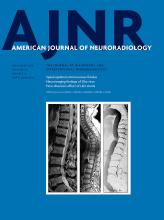Abstract
BACKGROUND AND PURPOSE: Impaired cerebrovascular reactivity has been associated with decreased cortical thickness in patients with arterial occlusive diseases. This study tests the hypothesis that severe hemodynamic impairment, indicated by increased oxygen extraction fraction ratios on positron-emission tomography with 15O tracers, is associated with decreased cortical thickness in patients with Moyamoya phenomenon.
MATERIALS AND METHODS: Patients with unilateral or bilateral idiopathic Moyamoya phenomenon were recruited. Oxygen extraction fraction ratio maps were generated from cerebral images of O[15O] counts divided by H2[15O] counts with normalization by corresponding cerebellar counts. The normal range of the oxygen extraction fraction ratio was estimated from historically available healthy control subjects. Cortical thickness was estimated from T1-weighted MR imaging and FreeSurfer. Regional samples of oxygen extraction fraction ratios and cortical thicknesses were drawn using FreeSurfer parcellations, retaining only parcellations from the vascular territory of the middle cerebral artery.
RESULTS: Complete MR imaging and PET datasets were available in 35 subjects, including 23 women; the mean age at scanning was 44 years. Patients with Moyamoya phenomenon had a significantly increased regional oxygen extraction fraction ratio compared with 15 healthy control subjects (P < .001). Regional oxygen extraction fraction ratio and age were significant predictors of cortical thickness (P < .001 for each) in a generalized linear mixed-effects model. Using hemisphere averages and patient averages, we found that only age was a significant predictor of cortical thickness (P < .001).
CONCLUSIONS: Chronic hemodynamic impairment, as indicated by a higher regional oxygen extraction fraction ratio, was significantly predictive of reduced cortical thickness in mixed-effects analysis of FreeSurfer regions. This phenomenon may be related to reversible metabolic down-regulation.
ABBREVIATIONS:
- OEF
- oxygen extraction fraction
- OEFR
- oxygen extraction fraction ratio
- SEM
- standard error of measurement
- © 2018 by American Journal of Neuroradiology
Indicates open access to non-subscribers at www.ajnr.org












